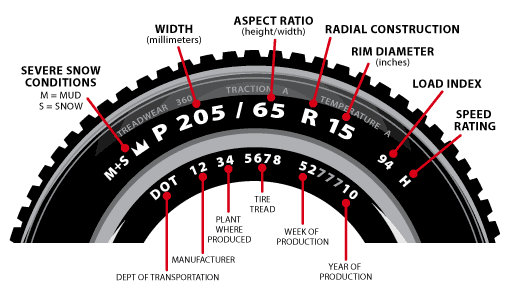How to Read Date Code on Tire
To read the date code on a tire, look for a 4-digit number stamped on the sidewall. This number indicates the week and year of manufacture.
When purchasing tires, it’s crucial to ensure they are not past their expiration date, as older tires can pose safety risks on the road. Understanding how to decode tire date codes will help you make informed decisions about maintaining your vehicle’s safety and performance.
By being aware of the manufacturing date, you can prioritize regular tire checks and replacements when necessary. Stay informed about your tire’s age to keep yourself and your passengers safe while driving.
Importance Of Reading Date Code On Tires
It is crucial to understand the significance of reading the date code on tires to ensure safety and performance. The age of a tire can greatly impact its stability, traction, and overall reliability. Learning how to decipher the date code empowers drivers to make informed decisions about their tires, contributing to safer journeys and improved vehicle maintenance.
Ensuring Safety
Checking the date code on tires is essential for ensuring safety on the road. Over time, the rubber compound in tires can degrade, leading to reduced grip and handling. By routinely examining the date code, drivers can identify aged tires that may be at risk of failure and take necessary precautions to avoid potential hazards while driving.
Determining Tire Age
The date code provides valuable information for determining tire age. It typically consists of a four-digit number, indicating the week and year of manufacture. Understanding the age of the tire allows drivers to schedule timely replacements, preserving optimal performance and minimizing the risk of blowouts or tread separation.

Credit: www.prioritytire.com
Components Of A Tire Date Code
The tire date code comprises a series of numbers and letters. It indicates the tire’s manufacturing date and other critical information for consumers to read accurately.
Understanding The Dot Number
The DOT number on a tire contains important information about its manufacturing date.
Decoding The Date Code
To decode the date code, look for the last four digits in the DOT number.
In a tire date code, the last four digits indicate the week and year of production.
| Position | Meaning |
|---|---|
| 1-2 | Week of manufacture |
| 3-4 | Year of manufacture |
Ensure to check the date code to determine the age of your tires for safety.
Deciphering The Dot Number
Deciphering the DOT number on your tire is a crucial skill for ensuring your safety on the road. The DOT number, which stands for Department of Transportation, holds valuable information about your tire’s origin and age.
Identifying The Plant Code
The plant code is the first two digits of the DOT number and it reveals the manufacturing location of the tire. This code helps track down any potential defects or recalls.
Decoding The Tire Size
The tire size is crucial for ensuring proper fitment and performance. It can be found after the plant code and consists of numbers indicating the tire’s width, aspect ratio, and wheel diameter.
Analyzing The Manufacturing Date
The last four digits of the DOT number represent the manufacturing date. The first two digits signify the week of production, while the last two denote the year. It’s important to check this date to ensure you are not driving on old or expired tires.

Credit: www.firestonecompleteautocare.com
Interpreting The Date Code
When it comes to ensuring the safety and performance of your vehicle, understanding how to read the date code on your tires is crucial. Interpreting the date code allows you to determine the week and year of manufacture as well as recognize the aging of your tires, helping you make informed decisions about their maintenance and replacement.
Determining The Week And Year Of Manufacture
To decipher the date code on your tires, you need to look for the DOT (Department of Transportation) code on the sidewall. It typically begins with the letters “DOT” followed by a series of numbers and letters. The last four digits represent the manufacturing date, with the first two indicating the week and the last two denoting the year. For instance, a code ending in “2318” would signify that the tire was manufactured in the 23rd week of the year 2018.
Recognizing The Aging Of Tires
As tires age, their rubber compounds degrade, leading to potential safety hazards. Understanding the date code enables you to assess the age of your tires, allowing you to monitor their condition and make informed decisions about maintenance and replacement. Tires older than six years should be carefully inspected, and those older than ten years should be replaced, regardless of their tread depth or overall condition.
Using The Date Code For Purchasing And Maintenance
When it comes to purchasing and maintaining tires, understanding how to read the date code is essential. The date code found on tires provides vital information about their age and condition, allowing you to make informed decisions regarding their purchase and maintenance. In this article, we will explore three important aspects of using the date code: checking tire age before purchase, monitoring tire age for maintenance, and replacing tires based on the date code. Let’s dive in!
Checking Tire Age Before Purchase
Before buying new or used tires, it is crucial to verify their age using the date code. The date code is a combination of numbers and letters stamped on the sidewall of each tire. It indicates the week and year of manufacture. To check the tire age, follow these steps:
- Locate the date code: On the sidewall of the tire, near the rim, you will find a serial number. Look for the last four digits, as they represent the date code.
- Decode the date code: The first two digits specify the week, while the last two digits indicate the year of manufacture. For example, if the date code is “2319,” it means the tire was manufactured on the 23rd week of 2019.
By checking the tire age before purchase, you can ensure that you are not buying old or expired tires. Older tires may have reduced performance and could pose a safety risk on the road.
Monitoring Tire Age For Maintenance
Once you have purchased your tires, it is important to continue monitoring their age for maintenance purposes. Tires age even when they are not in use, and their condition can deteriorate over time. To keep track of tire age, consider the following tips:
- Record the installation date: Keep a record of when the tires were installed on your vehicle. This will help you track their age accurately.
- Regular inspections: Inspect your tires periodically for signs of aging, such as cracking, bulging, or uneven wear. If you notice any abnormalities, it’s best to have them assessed by a professional.
- Keep track of mileage: Tires typically have a lifespan of around 6 years, regardless of the tread depth. If your tires have reached this age or have a significant number of miles, it may be time to consider replacing them.
By monitoring the age of your tires, you can proactively address any potential issues and ensure the safety and performance of your vehicle on the road.
Replacing Tires Based On Date Code
Knowing when to replace your tires based on the date code is crucial for your safety. While tread depth and overall condition are important factors, the age of the tires should not be overlooked. Here are some guidelines to consider:
- Consider the tire’s lifespan: Tires generally have a lifespan of 6 years, even if they have sufficient tread. After this time, the rubber compounds may begin to degrade, reducing their grip and performance.
- Check recommendations from manufacturers: Some tire manufacturers provide specific recommendations regarding tire age and replacement. Refer to their guidelines to determine when replacement is necessary.
- Err on the side of caution: If you are unsure about the safety of your tires, it is best to consult with a professional tire dealer. They can assess the condition of your tires and provide expert advice on whether replacement is needed.
Remember, your tires connect your vehicle to the road, so ensuring they are in good condition is vital for your safety and the performance of your vehicle. By understanding the date code and recognizing when it’s time to replace your tires, you can drive with peace of mind.

Credit: danthetireman.com
Frequently Asked Questions For How To Read Date Code On Tire
How Do You Read The Date On Tires?
You can read the date on tires by looking for a four-digit number on the sidewall. This number indicates the week and year of production. For example, 0519 means the tire was manufactured in the fifth week of 2019.
How Do You Decode A Tire Code?
To decode a tire code, look at the alphanumeric characters on the sidewall for information on size, type, and more.
How Long Are Tires Good By Date Code?
Tires are good by date code for about 6 years. It is recommended to replace them regardless of tread depth after this time.
What Is The 3 Digit Date Code On A Tire?
The 3-digit date code on a tire indicates its manufacturing date. It consists of the week and year of production. This information helps track the tire’s age and evaluate its safety and performance.
How Do I Read The Date Code On A Tire?
To read the date code on a tire, look for a four-digit number on the sidewall, where the last two digits represent the year and the first two digits indicate the week of manufacturing.
Why Is It Important To Read The Date Code On A Tire?
Reading the date code on a tire is important because it helps determine the age of the tire, enabling you to make informed decisions about safety, performance, and potential wear and tear.
Does The Date Code Affect Tire Performance?
Yes, the date code can impact tire performance as older tires may have compromised structural integrity, reduced traction, and increased risk of blowouts or tread separation.
Conclusion
Understanding how to read the date code on your tires is essential for ensuring your safety on the road. By following the simple guidelines provided, you can easily decode the manufacturing date and make informed decisions about your tire maintenance and replacement schedule.
Stay informed and take charge of your vehicle’s safety!
